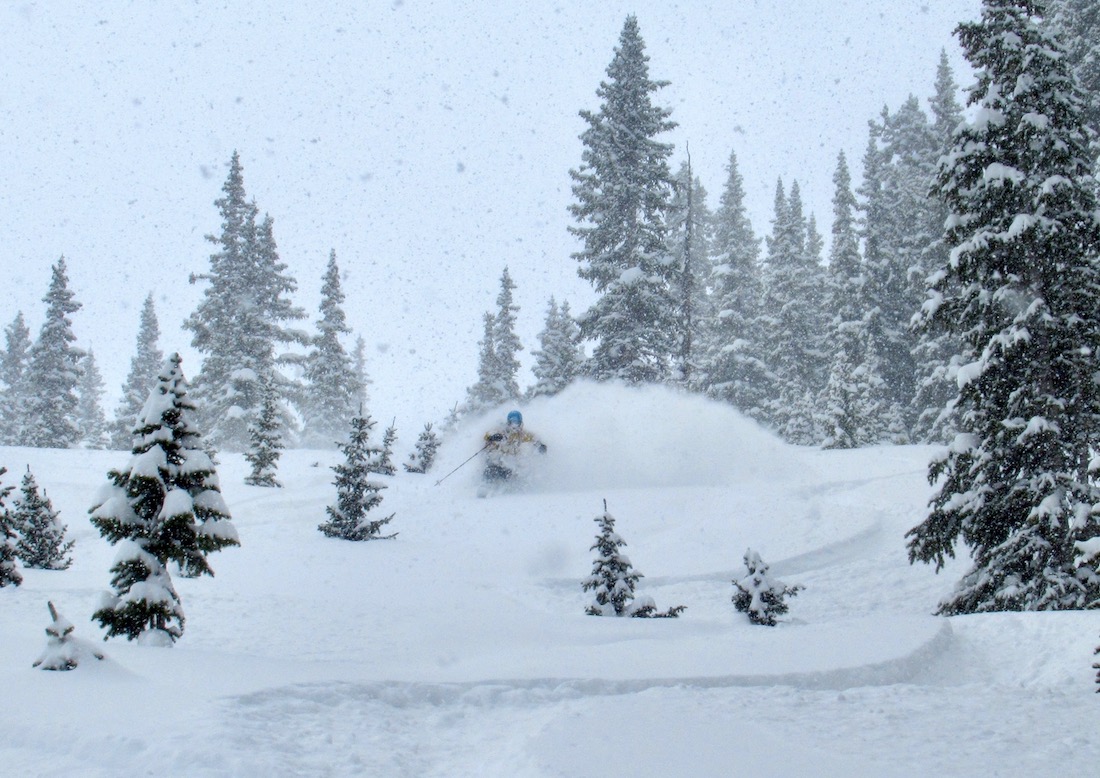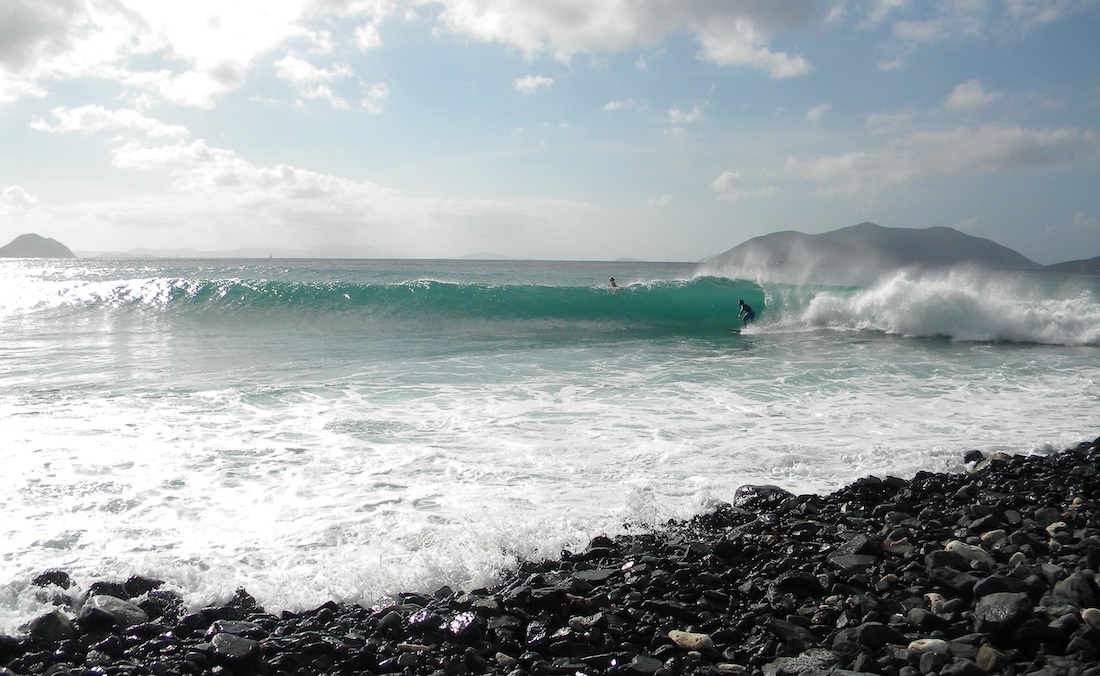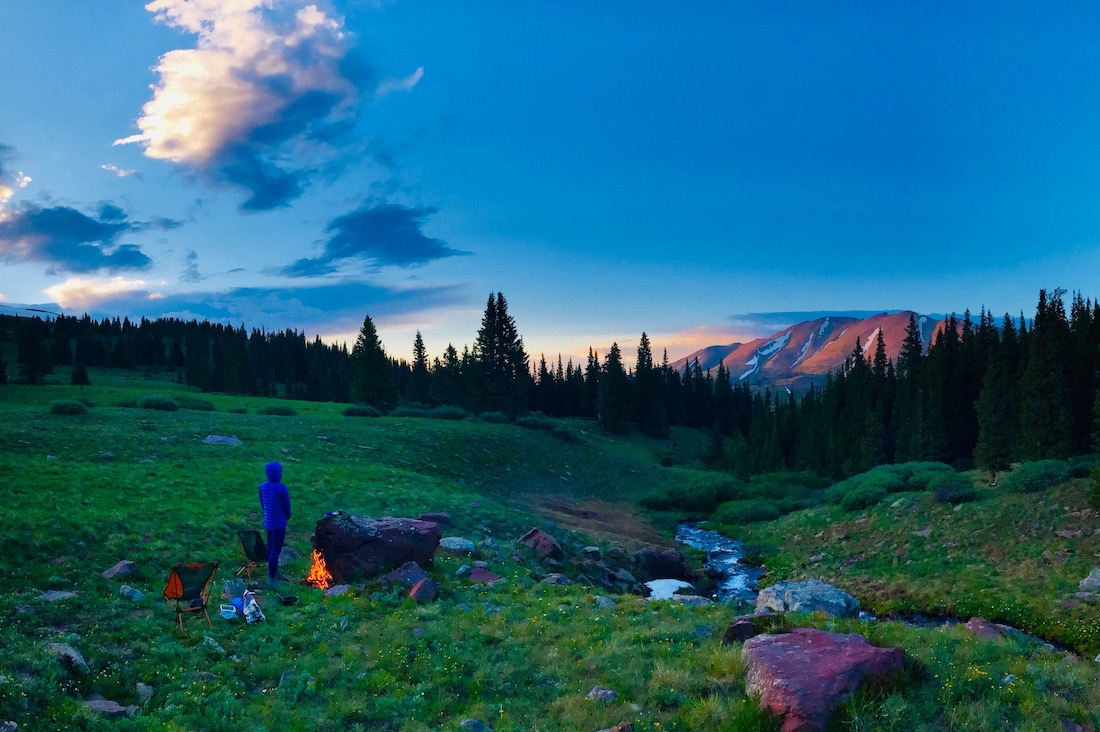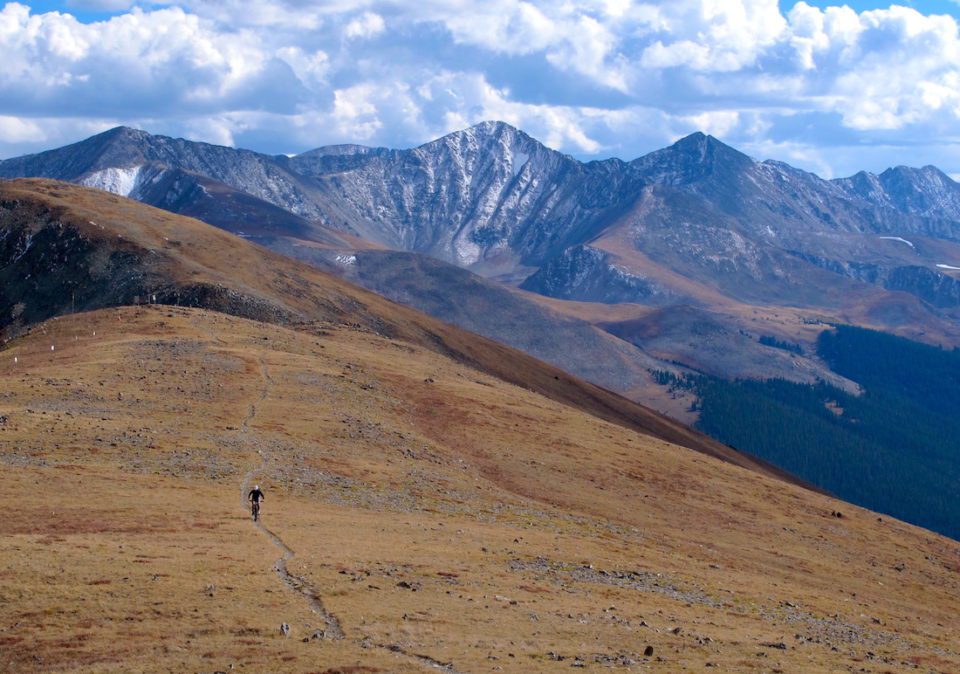I wake up antsy. I stand in the sun outside my front door and stretch my arms, staring at a vertical ocean of blue. My mountain bike has been propped against the deck since last night, chain lubed, frame washed. Seeing it glint makes me feel how I imagine a dog feels when he’s about to get taken somewhere awesome. I head inside to tend to our kids and eat breakfast, almost embarrassingly excited to ride alone on a Wednesday in August.
I estimate I’ll be out for six hours. I have a hard time not stopping and gaping on this loop. It is a rugged 32 miles with punishing climbs and descents and rarely more than a handful of people above treeline. You crest 12,300 feet three times, all on noodle-thin singletrack, and hike your bike a lot where it’s hard to breathe. Among the half dozen world-class big rides surrounding Breckenridge, Colorado, it’s easily my favorite simply because of where you get to go.
It costs a great deal to have world-class adventure available on a random Wednesday.
There was a time when I would not have known this existed, much less understood how to do it. I don’t like to think about that prospect now, but it does take luck to find a life outdoors. I was born in Connecticut and grew up on an island in the Caribbean, sailing, surfing, and playing baseball. I rarely made time for mountains while at college in Vermont. I moved to Costa Rica after school, then Washington, D.C., where I worked in a cubicle in a giant office building. My twin brother Sean and I left after a year to drive west. We intended to spend one night in Breckenridge, visiting a friend, before continuing on to Portland, Oregon, the next day.
I suppose the reason we stayed was the same reason why I still get giddy before an adventure at age 42. It seemed like it would enrich our lives.
Our story is not all that unique in these parts. Everyone comes for a quickie. Only some glimpse the magic. Fewer still seek it—need it—long term. And only a fraction of those believe that what it takes is worth it.
Thirty seconds after my wife and kids leave for work and school, I lather on the 50 SPF, stuff my lunch in my pack, and start pedaling. I tried to find a partner earlier in the week, called four friends who love alpine mountain biking. No one could commit. I had reason to bail, too; today’s ride means I will have to type through the night to finish a story. But, it hasn’t been this sunny and warm with so little wind for weeks. If I’m the only one who can stop me from doing something fun, I’ve learned, I’m probably not going to stop me. It’s why freelance writing is still a rich living, even if not monetarily.
At its essence, our trajectory in life represents a series of decisions we make—a mix of trades, really; gains and sacrifices. There is much to covet in an existence centered outdoors: freedom of schedule and movement, of exploration and exhilaration. I still rely on each of those benefits to affirm my decisions. But I also rue what I have given up, more often than I let on.
I remember being jealous as a kid when my friends skipped school during a big swell. They surfed all day while I sat in class. My buddy Sanji’s family lived far out on a point, where the sets smashed the rocks if the waves were up. I can imagine, now, how easy it must have been for his parents to justify stuffing their kids in the boat and zipping out to an empty, peeling righthander for the day’s education.
The whole reason we got to know them was because my mom inherited her dad’s wanderlust. Our grandfather, Robert Irving “Snuffy” O’Neil, was a mountaineering instructor in the Army’s famed 10th Mountain Division during World War II. He trained at Camp Hale just west of where I would settle 60 years later. He died suddenly at age 56 while we were in the womb. I still credit him indirectly for our mom’s decision to move us to St. John, which introduced me to the idea of a life outdoors.
We lived on a sailboat. Our first friend was a towhead named Galen. He lived up a steep hill in Fish Bay and ripped mushy windswell every day, eventually becoming the best surfer on the island. He also is a master painter, and many years later I bumped into one of his clients. The man, a local restaurateur, said Galen had showed up one day to let him know a rare swell had arrived and he was going surfing. The man told Galen if he went surfing he would be fired, but there was no debate to be had. Galen was not going to miss that swell.
In Vermont, when I was 21, I lived on a farm below the Green Mountains. Friends who knew how awesome mountains can be sought them out, and I can’t say I wasn’t envious of their glee when they came home from a powder day. But I still didn’t know I needed that. The year I spent in D.C., commuting on a gridlocked highway to a company that employed 10,000 people, changed my worldview. I realized for the first time what I didn’t want.

Breckenridge has never been known for having the rowdiest mountains. When Sean and I arrived in 2002, I had a broken foot and mediocre snowboarding skills. We spent our first few years getting to know the lifestyle, riding lifts in fleece vests and bar hopping at night. We lived in the town Nordic center our first summer and paid $125 apiece in rent. The building had no shower, so we hooked up a hose to the wall and sprayed ourselves down with snowmelt. I slept in the rental room under 50 pairs of skis that hung above my head like spears. Without a kitchen, we cooked our meals on the grill, which often attracted bears. They had usually gone home, however, by the time the sky exploded and we sat outside under a billion stars, marveling in silence.
The novelty of skiing at resorts and running town trails ultimately wore off, and I found myself drawn to what lay above and beyond. I sought out people who understood the magic on a higher level. The first was a pizzaman named Matt, who introduced me to backcountry skiing. I still have never met a purer version of the ski bum. I followed Matt up skintracks and learned the basics of evaluating snow and terrain. I also learned how electrifying it is to ski down a wild line. The freedom to go anywhere you want, on any mountain, on any day, still absolutely captivates me—as do the art and necessity of doing it safely.
Over a pint at the local brewpub one afternoon in my late 20s, I convinced a bartender named Dave to take me out for a ski tour. He personified the soul skier’s mystique. We became partners in all sorts of adventure. If you were somewhere up high with Dave, it was going to be interesting. I wormed my way in with other members of the local core, gradually learning the area’s nooks and crannies, supplementing their guidance with misadventures of my own. They also taught me about etiquette. I made mistakes—showed a stash to someone I shouldn’t have—and felt the full-circle sting when that person did the same.
In 2007, I quit my job at the daily newspaper and became a freelance writer. A dreadlocked cabin dweller named Jeff got me a part-time gig at a ski shop, to help pay my bills until writing took off. During my first shift, a coworker asked if I knew where to score a black-market vasectomy. I made $11 an hour and was overpaid. Jeff became a close friend and frequent ski buddy. He’d recently moved out of his 120-square-foot miner’s cabin after eight years. He liked the upgraded amenities he had in town, like running water and electricity, but he missed the wood-fired hot tub that he built on a creek at 11,000 feet.
Soon after starting at the ski shop, an avalanche forecaster named Scott got me a third gig. Scott was a senior member of the tight-knit crew of hutmasters who maintain four local backcountry cabins—a group that hadn’t welcomed a plebe in 10 years. Scott already had taken me under his wing as a skier, teaching what felt like a perpetual class in long-term survival. When the huts needed one more person to stir the poop, he recommended me.

For years I made an effort to reenter my past as often as possible. I pitched stories that took me to New England so I could visit old friends and haunts. Though our bonds remained strong, I felt a gradual gap open between my life’s direction and theirs. I drifted further from the geographical and professional bubbles I’d once viewed as potential destinations. This felt both rewarding and sad. I wished dearly that I could have their community, but, in the end, not at the expense of having our mountains.
Some came to Colorado on vacation, and I got to share my life with them, which was greatly fulfilling. However, trying to explain it to others—what I prioritized and why—became more difficult. I imagined that it sounded like I played all the time. Eventually, I stopped trying.
The sun warms my back as I pedal up the first of five substantial climbs, a creekside trail that winds through stands of lodgepole and aspen. I emerge from the forest into a wide alpine basin surrounded by steep rock walls. At the top awaits a swoopy, high-speed descent that is rarely ridden. The singletrack is exhausting; each pedal stroke seems to require twice as much output as the gentle dirt roads in the valley. Sweat drips into my eyeball, burning like hot sauce. Finally, after two hike-a-bikes and 40 minutes of pain, I reach the top and commence the descent. It is tacky and bitchin’. I hoot multiple times as loud as I can. The rush erases all memory of the pain that preceded it—and makes me wish I had a partner.
The ways in which people mine fun from mountains are infinite. In the Alps, they fly off giant cliffs with skis and a parachute. In Japan they schuss down volcanoes. In the Himalaya, they ascend to altitudes that can kill on their own. Each feat shows how impressive our species is. But the truth is most people who cultivate a life outdoors don’t do any of those things. Theirs is a more fundamental sanctuary. I am somewhere in the middle.
No matter how you experience the landscape, we go for similar reasons: to feel whole and scared and alive and fulfilled. During a ski expedition to western Nepal in 2009, at the most remote point of our trip, my partners and I encountered three Nepalese men hiking the same faint trail we were, but in the opposite direction. They were multiple days into a trek between villages, wearing sandals on a route with miles of snow, and they carried almost no gear (but they did, ahem, have plenty of aphrodisiacs to sell if we were looking?). We had just tiptoed across a terrifying bridge over a raging river with 60-pound packs and waterproof-breathable everything. Despite different objectives and lives, here we met, in an empty corner of the biggest, baddest mountain range on earth, immediately bonded by our shared experience, almost certain to never see each other again.

Halfway up the second climb, it is time to push again. The bike feels like a shopping cart with a broken axle. My lower back aches. I worry that I brought too much water. Bright red and pink flowers line the singletrack, and soon I’m at the final pitch, then on the ridge, looking back at where I started. I continue on for hours. Up, down, up again, stopping only to admire the reason I came. By the time I crest the Tenmile Range and begin the 3,200-foot descent into Frisco, I have taken 40 photos—probably the same 40 photos I took the last time I rode this loop. I encounter just one person, and I happen to know him: Lyle Knudson, a local running guru who coached seven Olympians. I haven’t seen him in years. We catch up for a few minutes then continue on our ways, heartened to have shared a pinnacle moment. It will be the last time I see Lyle before his death. Our exchange roots me ever more to the place.
Despite the beauty of world travel, my favorite part of any trip is driving into this valley where I live, wedged between 13,000- and 14,000-foot peaks, surrounded by land nobody owns. It is hard as hell to make a life last here—and getting harder every year. No longer are an area’s natural resources the primary price setter when it comes to mountain living. Now people pay for culture. And culture is expensive.
As I lament the differences, I’ve found myself drawn ever more to those who came and stayed for the land. I try to pay forward what I got from friends who showed me their ways, and who continue to. Nobody can control the growth, as much as I wish I could. But the peaks and trails and powder stashes never leave, and it’s important to remember that when we mourn the changes.
It costs a great deal to have world-class adventure available on a random Wednesday. Questioning your trades is inevitable. Freedom or career? Community or solitude? Safety or adrenaline? I live with my decisions, but that doesn’t mean I don’t regret what I give up.
I have two little boys, ages 6 and 3, and I strive to show them the essence that has captured my heart—without imposing it on them. It basically involves letting nature work its magic. My wife and I take them tent camping to places without playgrounds or cell service or toilets. Just a lot of dirt to play in, and empty areas to ride their bikes. They like hiking and looking at flowers, and the big one loves to ski powder.
Someday I will show them this mountain-biking loop that I love so much. I want to see their faces when the Continental Divide Trail drops under Peaks 3 and 4 and their arms rattle and cheeks shake. That is always when I feel the most gripped, like I’m barely hanging on. It’s what I remember afterward, along with the many miles above treeline, riding clear of the stress that weighs me down in the valley.
At the bottom of my descent, I start the last, longest climb toward home. It’s a good time to let the mind wander—a gradual ascent back to Breckenridge, then five more miles to our deck. I can already tell that tonight’s writing will hurt. I will want to go to bed at 8 o’clock. My eyelids will sag. I’ll try to rationalize putting off the story for another day. Ultimately, I will settle in with my bottle of caffeinated cola and pay the price of feeding my soul.
As always, it will be worth it.
Devon O’Neil is a freelance journalist based in Breckenridge, Colorado. His work has been published in the Best American Travel Writing and cited in the Best American Sports Writing, and can be viewed at devononeil.com. This piece first appeared at Polartec as is published here with permission.

